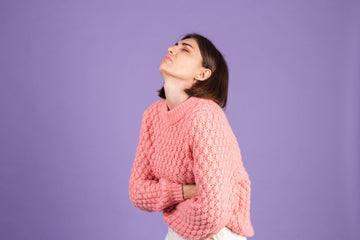Menstrual cramps cause minor abdominal pain due to uterine contraction, which causes blood during your period. While they usually start before or during the period, some women continue to feel cramps even after stopping bleeding. Hormonal changes can cause this, and the uterus still cleans the tissue or even early ovulation pain. During this time, some women also experience light spotting or discharge, which may make them feel uncomfortable. Using natural plant-based panty liners is a simple and effective way to protect your health, stay clean, and build confidence in these unexpected days. They help absorb light discharge, keep their underwear clean, and provide additional comfort while your body returns to its normal position after a period.
What Are Menstrual Cramps?
During a menstrual period, menstrual cramps are characterized by slow or intense pain felt in the lower abdomen. They will help remove the feed as a result of uterine contraction, which is the process of tissue and blood leaving the body during menstruation. Prostaglandins are substances similar to hormones and help cause these contractions. While moderate cramps are not unusual and regular, a few women experience more severe period cramps that can interfere with daily activities. Understanding the causes of cramps helps you develop a more effective strategy to manage and alleviate them.
Why Do Cramps Continue After Your Period Ends?
Hormonal Changes After Bleeding Stops
Even after your period ends, hormone levels can take time to return to normal. Fluctuating hormones may still trigger mild uterine contractions or sensitivity, causing cramps. This temporary imbalance is usually harmless but can leave you feeling discomfort for a few extra days until your body fully stabilizes.
The Uterus Still Clears Leftover Blood or Tissue
Sometimes, the uterus may additionally experience gentle contractions to push out any leftover blood or tissue after periods. This natural clearing technique can cause moderate cramps or a dragging ache feeling, even when the bleeding has stopped. It normally resolves on its own without special treatment.
Possible Early Ovulation Pain
Some girls ovulate earlier than expected after their period ends, inflicting a quick, sharp pain known as mittelschmerz. This can feel like menstrual cramps and generally happens on one side of the lower abdomen. While innocent, this mid-cycle pain may be unexpected if you're not now watching for it.
Underlying Medical Conditions
Conditions like endometriosis, fibroids, or pelvic infections can cause ongoing cramps even after periods. These situations create extra inflammation or unusual tissue growth, leading to lasting aches. If cramps are intense or persist for many days, it’s important to see a doctor to check for those underlying causes.
Digestive Issues That Feel Similar to Cramps
Sometimes, digestive issues, which include gas, period bloating, or constipation, can mimic menstrual cramps. After your period, changes in weight-reduction plan or hormones may also have an effect on digestion, causing abdominal soreness that appears like cramps. Recognizing the difference enables you to manage signs and symptoms more effectively and avoid unnecessary worry about menstrual health.
How to Manage Cramps After Period?
-
You can relax your muscles and reduce cramps after training by using heat, such as a hot water bottle or a warm bath.
-
Stretching and low exercise increase blood flow, reduce pain, and make your body feel more relaxed and comfortable.
-
You can make a plan to drink sufficient water, and consuming light meals can help alleviate bloating and reduce the severity of cramps.
-
Although taking opioids can help handle more severe pain, you should do this only after talking to the doctor.
-
When you experience a mild discharge or notice it after your period stops, using panty liners helps you stay fresh, dry, and confident.
When Should You See a Doctor?
Suppose you have excessive or worsening pain that does not improve with home care, as it could imply a severe problem. Pain that persists for many days after your period ends isn't always normal and might be a sign of situations like infections or endometriosis. Other warning symptoms include fever, ideal choice for heavy bleeding, or unusual discharge, which could be a sign of infections or other health issues requiring immediate attention. If cramps interfere with your everyday activities and have an effect on your normal lifestyle, it is also critical to seek scientific assistance. Getting checked early can help discover the cause, prevent headaches, and ensure you get proper treatment to experience better and live healthily.
Self-Care Tips for Extra Comfort
|
Conclusion
Cramps after your period can take place because of leftover hormonal adjustments, the uterus clearing out tissue, early ovulation, or other health conditions like endometriosis or infections. Most of the time, these cramps are not serious and may be controlled with easy self-care steps like the use of heat, mild exercise, and staying hydrated. However, if the ache is severe, lasts many days, or comes with unusual signs, it’s essential to see a physician to discover the actual cause. During this time, the use of pantyliners allows you to be comfortable during your light period or discharge. Listening to your body and being concerned for it well will let you experience more confidence and comfort after your period.
FAQ’s:
Why Do I Have Menstrual Cramps Even After My Period Ends?
Hormonal changes can continue even after the stops of bleeding, which maintains the uterine contract and leads to mild cramps for a few extra days.
Are Cramps Normal After The Period?
Light cramps after periods can be normal and usually go on their own. However, if symptoms are severe or persist for a long time, it is best to consult a doctor.
Can Early Ovulation Cause Menstrual Cramps?
Yes, some women ovulate immediately after their period, which leads to sharp or dull cramps, known as ovulation pain. It is usually harmless and short-lived.
Cramps After Periods Can Mean Health Issues?
Yes, they may be an indication of endometriosis, fibroids, or infections. If the pain is severe or accompanied by other symptoms, seeking medical advice is important.
How Can I Reduce Menstrual Cramps After A Period?
Using heat, gentle stretch, hydration, and pain relief (with a doctor's advice) can help. If there is a mild discharge, pantyliners can make you feel fresh.





